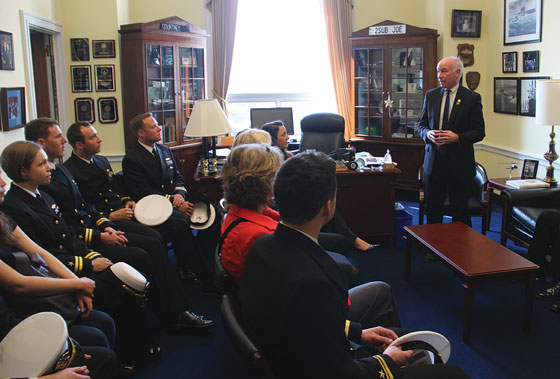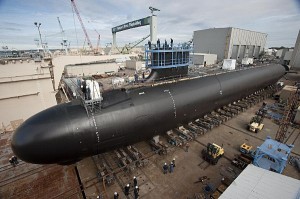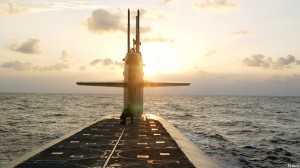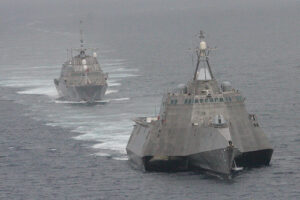
Rep. Joe Courtney meets with young submarine officers.
WASHINGTON: While big-ticket additions to the Navy budget like F-35 fighters and Littoral Combat Ships didn’t survive conference, there are several smaller but strategic plus-ups in the annual defense policy bill that make a major difference for the fleet, Rep. Joe Courtney told me this afternoon. What’s more, with House Armed Services Committee chairman Mac Thornberry pushing for a supplemental bill early next year, Courtney said, there’ll be another shot at adding weapons systems in what’s likely to be a less constrained political environment for defense spending.

The Virginia-class attack submarine USS Minnesota under construction in Newport News.
Courtney is the ranking Democrat on the House seapower subcommittee and long-time bipartisan battle buddy of Republican Rep. Randy Forbes, who lost his primary but is expected to stay in DC as Donald Trump’s Secretary of the Navy. Trump’s plans are unpredictable but his ambitious pledges to rebuild the military would add an estimated $60 billion to the budget.
“We left some items on the cutting room floor (in conference), but it’s going to be obviously a new alignment starting in January,” Courtney said. “Thornberry’s not mincing words that he wants not to wait ’til 2018’s fiscal year to try to address some of those shortfalls.”
For now, though, what’s so wonderful in the 2017 National Defense Authorization Act? First is $85 million in advanced procurement for Virginia-class submarines: That was in doubt “up until a couple of days ago,” Courtney told me. While the sum seems small by Pentagon standards, the money is critical to get started on long-lead-time work and other early steps to getting more attack subs to the fleet on time. It’s “like a centipede,” Courtney said: Any one segment may seem small, but cut one and the whole sequence falls apart.

An Ohio-class nuclear missile submarine (SSBN).
The bill also expands the authorities for the National Sea-Based Deterrence Fund, a Forbes-Courtney creation to help acquire the future Columbia-class replacement for the aging Ohio-class nuclear missile submarines. Monies in the fund already are exempted from many of the bureaucratic restrictions on the normal Shipbuilding & Conversion, Navy (SCN) account; now the new language in NDAA would allow “continuous production” of missile compartment components. (Continuous means production of components would not be tied to contracts individual submarines, allowing for greater efficiencies of scale).
That said, Courtney admits, there’s not actually any money in the Fund for it to spend: It’s a innovative vehicle with no gas in the tank. That will change, he told me, probably early next year: “Frankly, the Navy and Treasury are going to have start doing something with that fund because it’s the law of the land.”
Regular Navy accounts include some $1.9 billion for the Ohio Replacement Program in 2017, a figure that was never in contention. But the Navy can only spend $1.2 billion of it, the 2016 figure, as long as government is operating on autopilot under a Continuing Resolution, which sets spending at prior year levels in the absence of program appropriations bills. Both the White House and Navy allies in Congress are pushing for the CR now being drafted to make an exception or “anomaly” to let the sub program spend the $770 million difference. Passing the NDAA will help put pressure on the appropriators to allow the Navy to spend the full $1.9 billion, Courtney said.

LPD-24, the USS Arlington, under construction
Surface Ships
The NDAA also makes important decisions on surface warships. Notably, it gives the Navy authority to enter into an incrementally funded contract — as opposed to the normal process of paying for the whole ship up front — for a new amphibious warfare ship, either an additional San Antonio-class Landing Platform Dock (to be called the LPD-29) or a scaled-down San Antonio called an LX(R).
The bill also ties the next Defense Secretary’s hands somewhat on the controversial Littoral Combat Ship, in particular because it requires keeping both shipyards currently building LCS — Austal and Marinette Marine — until one has won a competition to build the upgraded frigate version. The House also tried to add a third LCS to 2017’s production plan to ensure both yards have enough work, but the final conference report cut the number of ships back down to two.

LCS-2, USS Independence, followed by LCS-1, USS Freedom, showing the two different designs.
“It’s my understanding that the two LCS is enough to keep the two shipyards alive,” Courtney told me. “The new administration should get a chance to take a look at this program before Congress made some existential choice” such as eliminating one of the two yards.
Then there’s the controversial future flagship of the fleet, the Ford-class aircraft carrier. After much debate over potential changes to the technologically troubled and badly delayed program, particularly the Advanced Arresting Gear intended to let planes land on the flattop, the conference decided to let the Navy proceed on its current course.
“The arresting gear issue with the carriers is something that has been a non-stop topic with the committee staff and members, McCain in particular,” Courtney said, “(but) it appears that there’s been real progress made on the arresting gear and the catapult as well. The plan is they’re going to have a commissioning In the spring or early summer. At this point, people felt like there wasn’t any more we could do legislatively.”

The new carrier USS Ford is afloat but still unfinished.
Before Courtney ran to a roll call for a vote, I asked him what it would be like next year without Randy Forbes as seapower subcommittee chairman. “He really is an impressive guy (and) a perfect gentleman to work with,” despite partisan differences, Courtney said. “I’ve got my fingers crossed that he may morph into some other area of public life that we can continue to work on navy issues.”
Such as, I suggested innocently, the deputy assistant secretary of Interior? Courtney laughed out loud. Sure, he said: “We can work out the sage grouse.”
Why supporting Ukraine is ‘main priority’ for Norway’s defense chief this year
“I have more sense of urgency in 2024 than I had in 2023” about how quickly Russia can rearm its military, Norway’s Chief of Defense, Gen. Eirik Kristoffersen, told Breaking Defense.


























